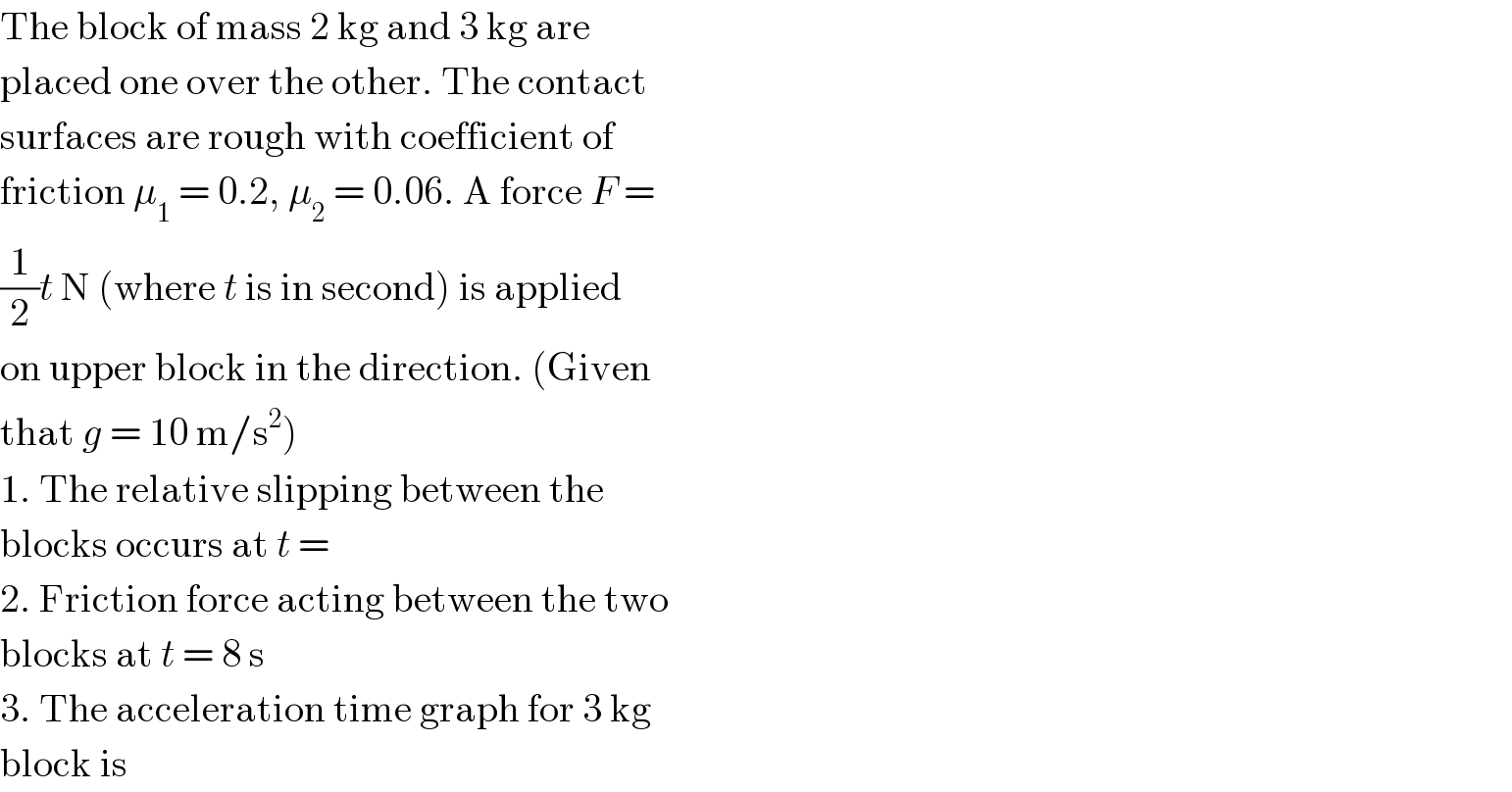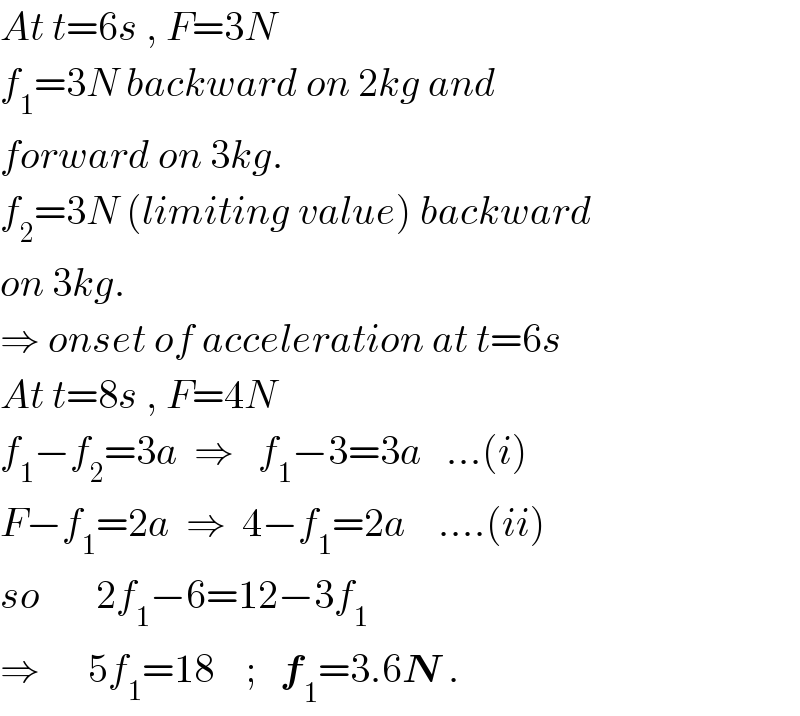
Question Number 21670 by Tinkutara last updated on 30/Sep/17

$$\mathrm{The}\:\mathrm{block}\:\mathrm{of}\:\mathrm{mass}\:\mathrm{2}\:\mathrm{kg}\:\mathrm{and}\:\mathrm{3}\:\mathrm{kg}\:\mathrm{are} \\ $$$$\mathrm{placed}\:\mathrm{one}\:\mathrm{over}\:\mathrm{the}\:\mathrm{other}.\:\mathrm{The}\:\mathrm{contact} \\ $$$$\mathrm{surfaces}\:\mathrm{are}\:\mathrm{rough}\:\mathrm{with}\:\mathrm{coefficient}\:\mathrm{of} \\ $$$$\mathrm{friction}\:\mu_{\mathrm{1}} \:=\:\mathrm{0}.\mathrm{2},\:\mu_{\mathrm{2}} \:=\:\mathrm{0}.\mathrm{06}.\:\mathrm{A}\:\mathrm{force}\:{F}\:= \\ $$$$\frac{\mathrm{1}}{\mathrm{2}}{t}\:\mathrm{N}\:\left(\mathrm{where}\:{t}\:\mathrm{is}\:\mathrm{in}\:\mathrm{second}\right)\:\mathrm{is}\:\mathrm{applied} \\ $$$$\mathrm{on}\:\mathrm{upper}\:\mathrm{block}\:\mathrm{in}\:\mathrm{the}\:\mathrm{direction}.\:\left(\mathrm{Given}\right. \\ $$$$\left.\mathrm{that}\:{g}\:=\:\mathrm{10}\:\mathrm{m}/\mathrm{s}^{\mathrm{2}} \right) \\ $$$$\mathrm{1}.\:\mathrm{The}\:\mathrm{relative}\:\mathrm{slipping}\:\mathrm{between}\:\mathrm{the} \\ $$$$\mathrm{blocks}\:\mathrm{occurs}\:\mathrm{at}\:{t}\:= \\ $$$$\mathrm{2}.\:\mathrm{Friction}\:\mathrm{force}\:\mathrm{acting}\:\mathrm{between}\:\mathrm{the}\:\mathrm{two} \\ $$$$\mathrm{blocks}\:\mathrm{at}\:{t}\:=\:\mathrm{8}\:\mathrm{s} \\ $$$$\mathrm{3}.\:\mathrm{The}\:\mathrm{acceleration}\:\mathrm{time}\:\mathrm{graph}\:\mathrm{for}\:\mathrm{3}\:\mathrm{kg} \\ $$$$\mathrm{block}\:\mathrm{is} \\ $$
Commented by Tinkutara last updated on 30/Sep/17

Answered by ajfour last updated on 30/Sep/17

$${At}\:{t}=\mathrm{6}{s}\:,\:{F}=\mathrm{3}{N} \\ $$$${f}_{\mathrm{1}} =\mathrm{3}{N}\:{backward}\:{on}\:\mathrm{2}{kg}\:{and} \\ $$$${forward}\:{on}\:\mathrm{3}{kg}. \\ $$$${f}_{\mathrm{2}} =\mathrm{3}{N}\:\left({limiting}\:{value}\right)\:{backward} \\ $$$${on}\:\mathrm{3}{kg}. \\ $$$$\Rightarrow\:{onset}\:{of}\:{acceleration}\:{at}\:{t}=\mathrm{6}{s} \\ $$$${At}\:{t}=\mathrm{8}{s}\:,\:{F}=\mathrm{4}{N} \\ $$$${f}_{\mathrm{1}} −{f}_{\mathrm{2}} =\mathrm{3}{a}\:\:\Rightarrow\:\:\:{f}_{\mathrm{1}} −\mathrm{3}=\mathrm{3}{a}\:\:\:...\left({i}\right) \\ $$$${F}−{f}_{\mathrm{1}} =\mathrm{2}{a}\:\:\Rightarrow\:\:\mathrm{4}−{f}_{\mathrm{1}} =\mathrm{2}{a}\:\:\:\:....\left({ii}\right) \\ $$$${so}\:\:\:\:\:\:\:\mathrm{2}{f}_{\mathrm{1}} −\mathrm{6}=\mathrm{12}−\mathrm{3}{f}_{\mathrm{1}} \\ $$$$\Rightarrow\:\:\:\:\:\:\mathrm{5}{f}_{\mathrm{1}} =\mathrm{18}\:\:\:\:;\:\:\:\boldsymbol{{f}}_{\mathrm{1}} =\mathrm{3}.\mathrm{6}\boldsymbol{{N}}\:. \\ $$
Commented by Tinkutara last updated on 30/Sep/17

$$\mathrm{Thank}\:\mathrm{you}\:\mathrm{very}\:\mathrm{much}\:\mathrm{Sir}! \\ $$$$\mathrm{Can}\:\mathrm{you}\:\mathrm{answer}\:\mathrm{other}\:\mathrm{2}?\:\mathrm{Because}\:\mathrm{they} \\ $$$$\mathrm{do}\:\mathrm{not}\:\mathrm{match}\:\mathrm{answer}. \\ $$
